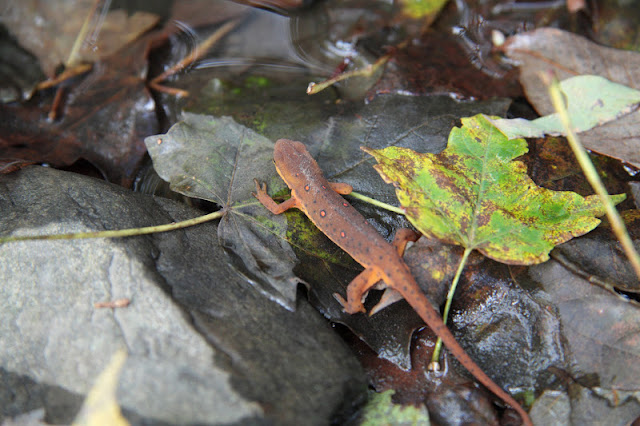Lindsay-Parsons contains a wide array of habitats, making it home to many different species.
Fields
Ponds
A beaver pond
Forest
We started our searching near Coleman Lake. There, we saw a painted turtle (Chrysemys picta) basking on a log and a good-sized water snake (Nerodia sipedon).
(Really, there's a painted turtle in this photo. It's the tiny speck left of the avian reptiles.)
The water snake was about to shed, as you can see by the blue-ish eyecap. Since he couldn't see very well, he was probably extra cranky, and did what water snakes do best: strike at and poop on people.
A demonstration of the snake's stinky defense mechanism.
We also found a green frog, Rana clamitans.
After Coleman Lake, we headed on to an abandoned shed known to shelter black rat snakes, Pantherophis obsoletus. While we didn't find any live snakes there, perhaps because they had already gone out to sun themselves, we did see snake vertebra.
Once in the woods and near the streams, we began to find more amphibians.
Flipping a log to look for salamanders.
An American toad, Bufo americanus
A juvenile red-spotted newt, a.k.a. a red eft (Notopthalmus viridescens)
Betsy had a permit to collect some red efts and red-backed salamanders for educational purposes.
Two for one: this streamside rock hid both a green frog and a red eft.
We were surprised by the lack of salamander species other than red-spotted newts, but after lunch they began to appear. The group saw mountain dusky salamanders (Desmognathus ochrophaeus), red-backed salamanders (Plethodon cinereus), slimy salamanders (Plethodon glutinosus), and spotted salamanders (Ambystoma maculatum).
Our final species count:
Painted turtle, Chrysemys picta- 3
Water snake, Nerodia sipedon- 1
Green frog, Rana clamitans- 21+
Spring peeper, Pseudacris crucifer- 3
Red eft, Notopthalmus viridescens- 21
American toad, Bufo americanus- 1
Redback salamander, Plethodon cinereus- 45
Slimy salamander, Plethodon glutinosus- 9
Mountain dusky salamander, Desmognathus ochrophaeus- 13
Pickeral frog, Rana palustris- 1
Spotted salamander, Ambystoma maculatum- 2
Photos: Jessica Tingle.



































